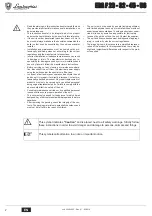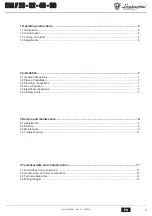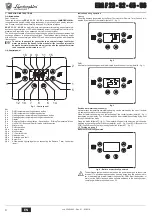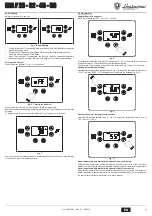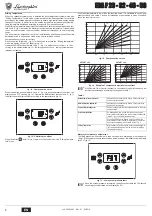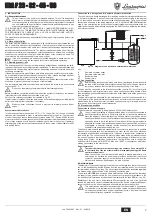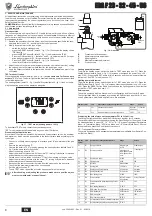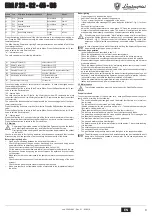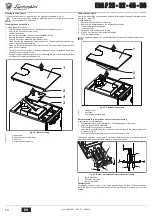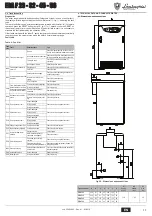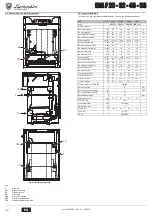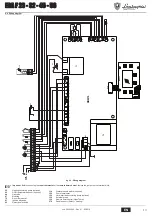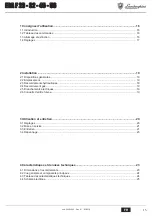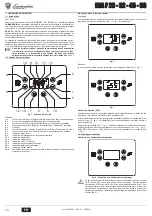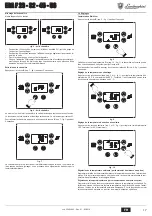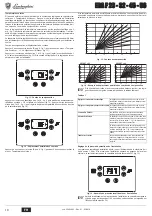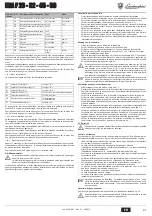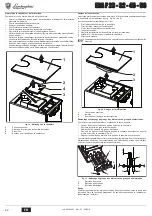
ERA F 23 - 32 - 45 - 56
7
EN
2. INSTALLATION
2.1 General Instructions
B
This unit must only be used for its intended purpose. This unit is designed to
heat water to a temperature below boiling point at atmospheric pressure and
must be connected to a heating system and/or a hot water system for domestic
use, compatible with its performance, characteristics and heating capacity. Any
other use is considered improper.
THE BOILER MUST ONLY BE INSTALLED BY QUALIFIED PERSONNEL, IN AC-
CORDANCE WITH ALL THE INSTRUCTIONS GIVEN IN THIS TECHNICAL MANUAL,
THE PROVISIONS OF CURRENT LAW, ANY LOCAL REGULATIONS AND THE
RULES OF PROPER WORKMANSHIP.
The manufacturer declines any responsibility for damage or injury caused by incorrect
installation.
2.2 Place of installation
The boiler must be installed in a special room with ventilation openings towards the out-
side in conformity with the current regulations. If there are several burners or extraction
units that can work together in the same room, the ventilation openings must be sized for
simultaneous operation of all the units. The place of installation must be free of flamma-
ble objects or materials, corrosive gases, volatile substances or dusts which, sucked by
the burner fan, can obstruct the pipes inside the burner or the combustion head. The
room must be dry and not exposed to rain, snow or frost.
A
If the unit is enclosed in a cabinet or mounted alongside, a space must be pro-
vided for removing the casing and for normal maintenance operations.
2.3 Plumbing connections
The heating capacity of the unit must be previously established by calculating the build-
ing's heat requirement according to current regulations. To ensure proper operation and
long boiler life, the plumbing system must be adequately sized and complete with all the
necessary accessories.
If the delivery and return pipes follow a path where air pockets could form in certain plac-
es, it is advisable to install vent valves at these points. Also, install a discharge device at
the lowest point in the system to allow its complete emptying.
If the boiler is installed at a lower level than the system, it is advisable to provide a flow-
stop valve to prevent the natural circulation of system water.
The temperature drop between the delivery manifold and the return to the boiler should
not exceed 20° C.
B
Do not use the water system pipes to earth electrical appliances.
Before installation, carefully wash all the pipes of the system to remove any residuals or
impurities that could affect proper operation of the unit.
Carry out the relevant connections as indicated in fig. 22.
It is advisable to install on-off valves between the boiler and heating system allowing the
boiler to be isolated from the system if necessary.
B
Make the boiler connection in such a way that its internal pipes are free of
stress.
System water charcteristics
In the presence of water harder than 25° Fr (1°F = 10ppm CaCO
3
), the use of suitably
treated water is advisable in order to avoid possible scaling in the boiler. The treatment
must not in any case reduce the hardness to values below 15°F (Decree 236/88 for uses
of water intended for human consumption). Water treatment is indispensable in the case
of very large systems or with frequent replenishing of water in the system. If partial or
total emptying of the system becomes necessary in these cases, it is advisable to refill it
with treated water.
Connection to a storage tank for domestic hot water production.
The unit's electronic board is arranged for managing an external storage tank for domes-
tic hot water production. Carry out the plumbing connections according to the diagram
fig. 16 (pumps and non-return valves must be supplied separately). Carry out: electrical
connections as shown in the wiring diagram in cap. 4. A probe LAMBORGHINImust be
used. At the next lighting, the boiler's control system recognises the presence of the hot
water tank probe and automatically configures the DHW function, activating the display
and relevant controls.
fig. 16 - Diagram of connection to external hot water tank
Key
8
Domestic hot water outlet
9
Domestic cold water inlet
10
System delivery
11
System return
2.4 Gas connection
B
Before making the connection, make sure the unit is arranged for operation with
the type of fuel available and carefully clean all the pipes of the gas system to
remove any residues that could affect proper functioning of the boiler.
The gas must be connected to the relevant connection (see fig. 22) in conformity with
current standards, with a rigid metal pipe or with a continuous surface flexible s/steel
tube, installing a gas cock between the system and boiler. Make sure all the gas connec-
tions are tight.
The gas meter must be adequate for the simultaneous use of all units connected to it.
The diameter of the gas pipe leaving the boiler does not determine the diameter of the
pipe between the unit and the meter; it must be chosen according to its length and pres-
sure losses, in conformity with current standards.
2.5 Electrical connections
Connection to the power supply
The boiler must be connected to a single-phase 230 Volt-50 Hz electric line.
B
The unit's electrical safety is only guaranteed when it is correctly connected to
an efficient earthing system in conformity with the current safety standards.
Have the efficiency and suitability of the earthing system checked by profes-
sionally qualified personnel; the Manufacturer declines any liability for damage
caused by failure to earth the system. Also make sure the electrical system is
adequate for the maximum power absorbed by the unit, as specified on the boil-
er dataplate, in particular ensuring that the section of the system's cables is
suitable for the power absorbed by the unit.
The boiler is prewired and supplied standard with connectors for connection to possible
accessory components such as circulating pumps, mixer valves, as well an electronic
thermostatic controller (see wiring diagrams). It also has a connector for connection to
the electric line. The connections to the mains must be made with a permanent connec-
tion and equipped with a double-pole switch with contact opening of at least 3 mm, inter-
posing fuses of max. 3A between the boiler and the line. Make sure to respect the
polarities (LINE: brown wire / NEUTRAL: blue wire / EARTH: yellow/green wire) when
making connections to the electric line.
Room thermostat
B
The room thermostat must have voltage-free contacts. Connecting 230 V.
to the terminals of the room thermostat will irreparably damage the flame
control electronic unit.
When connecting a room thermostat with a daily or weekly programme, or a
timer switch, do not take the power supply for these devices from their cutout
contacts. Their power supply must be taken with a direct connection from the
mains or with batteries, depending on the kind of device.
2.6 Air/fume ducts
The diameter of the connecting pipe to the flue must not be less than that of the connec-
tion on the anti-backflow device. Starting from the anti-backflow device it must have a
vertical section at least 50 cm long. The current regulations must be respected regarding
the dimensioning and installation of the flues and connection pipe.
The boiler is a
B11BS
type equipped with a safety device (fume thermostat) that stops
the supply of gas and shuts down the unit in case of poor draught or disturbance in the
fume exhaust. Unit shutdown is indicated on the display with the code
F04
(ref. cap. 3.4).
Restarting of the unit occurs automatically 20 minutes after the end of the fault that
caused the problem. In case of repeated intervention of the device, contact qualified per-
sonnel to check the flue and chimney and eliminate the fume evacuation fault.
B
This safety device must never be tampered with or deactivated. Any operation
on the device, or its replacement, must only be carried out by qualified person-
nel using the manufacturer's original replacement parts. A functional test must
be carried out after any operation on the device.
8
9
10
11
cod. 3540L893 - Rev. 01 - 03/2018


